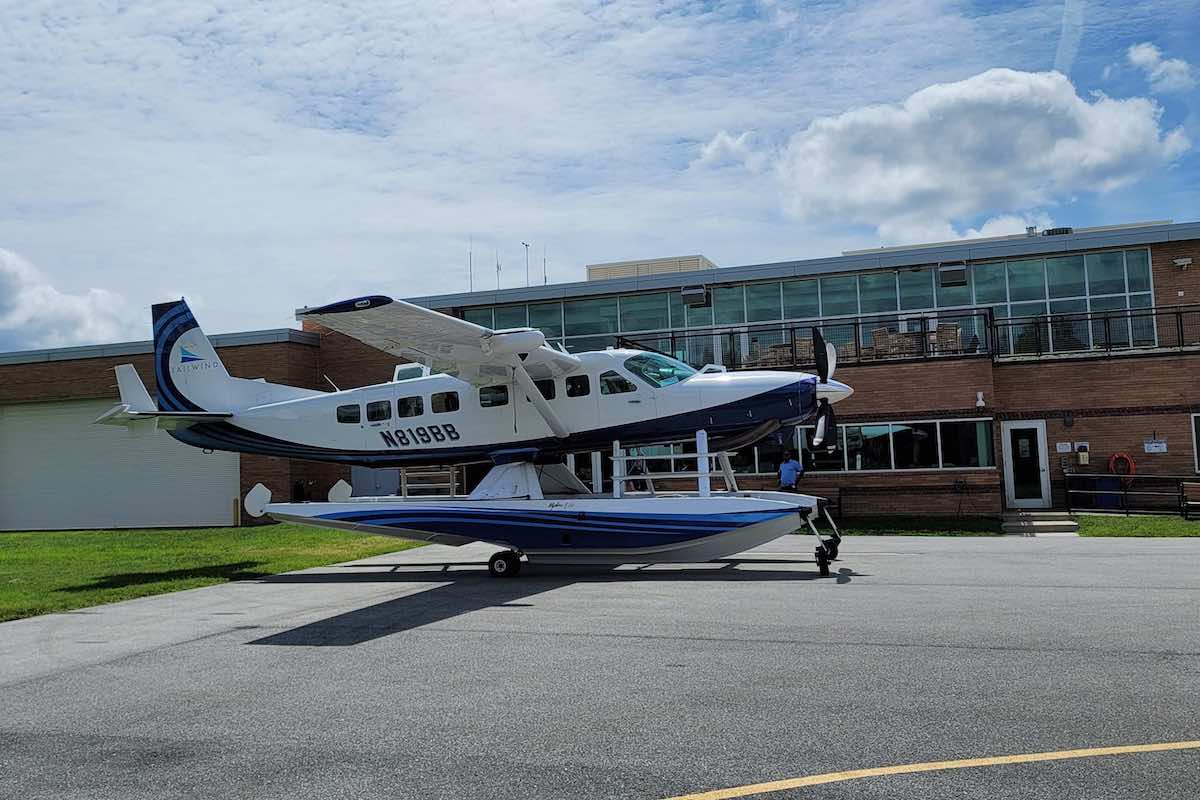Photo credit: A Tailwind Air seaplane at the airport in College Park, Md. Tailwind Air
A watered down, or should we say landed-down, version of seaplane operator Tailwind Air’s plan of waterfront-to-waterfront flights between New York and Washington, D.C., launches next month.
The airline, which surprised many when it unveiled ambitions to serve Washington’s waterfront with commercial flights in May, is taking what many expected: a land-based approach to flying to the U.S. capital. Tailwind will begin twice daily flights between its New York base on the east side of Manhattan at 23rd Street and the Washington suburb of College Park, Md., on September 13. Flights will operate all year except for late December through mid-March when the short winter days and weather conditions make landing on New York’s East River difficult.
“Our long-term goal is to land in the Potomac,” said Peter Manice, co-founder and director of scheduled services at Tailwind. “It seems like that’s going to take us a little bit more time. We’d like to start by building a market.”
College Park will not be Tailwind’s first land-based destination, Manice said. While its New York base is on water, Tailwind also uses airports on land in East Hampton and Montauk, N.Y., and Provincetown, Mass.
“I think it’s going to be a stretch,” Bob Mann, an adviser at R.W. Mann & Company and former airline executive, said of Tailwind’s planned Washington flights. “I just don’t think it has the same draw as their existing services [to Boston]. It’s probably going to be a tougher introduction.”
College Park, which does benefit from an inside-the-Beltway — the circumferential highway that surrounds Washington — location, lacks the convenience of Tailwind’s flagship seaplane service to Boston Harbor from New York. The suburban D.C. airport is a 22 minute drive to the U.S. Capitol without traffic, and longer to downtown, according to Google Maps. And it’s even farther from both locations than Washington’s close-in Reagan National Airport. National boasts three competing air shuttles to New York’s LaGuardia and Newark airports.
Tailwind’s dream of flights to Washington’s Potomac waterfront faces steep hurdles. The city’s airspace is governed by the DCA Access Standard Security Program, which was put in place after the 9/11 terrorist attacks in 2001 to maintain security aboard general aviation flights into and out of National airport. The rules require that each passenger be vetted and screened by the U.S. Transportation Security Administration at a specified gateway airport — none of which are Tailwind’s New York gateway — before the flight. Commercial flights into and out of National airport are exempt. The FAA also maintains a 15-mile restricted zone around National that includes all of D.C.’s waterfront.
In addition to the airspace rules, Tailwind would need approvals from local and federal authorities to takeoff and land on the Potomac. The District controls the river along its shores, though the U.S. Coast Guard has some jurisdiction, and the TSA oversees security.
Hence College Park. The runway at the sleepy general aviation airport is abutted on one end by a line on Washington’s Metro system and a popular bike trail on the other. The University of Maryland’s largest campus is less than a mile away. And the airport is probably best known for its history as one of the oldest in the U.S.; it pre-dates the city’s main commercial gateways, Dulles and National airports, by decades.
Manice, however, is all about the benefits of Tailwind’s new service. Travelers will not need to pass through TSA checkpoints, which allows them to arrive minutes before their flights. The airline’s eight-passenger planes offer a “private-like” experience. And the New York-College Park flight, in his estimation, will still be faster than Amtrak’s Acela train service or the competing air shuttles. Tailwind flights will take 80-90 minutes not including travel time into D.C., while Amtrak lists the fastest New York-Washington Acela time at 2 hours and 47 minutes.
“It’s not a solution for everyone,” Manice said. “We’re not trying to draw a million people onto our airplanes.”
And, with fares ranging from $395 to $795 one way per person, the flights are certainly not for everyone. Asked who Tailwind’s target Washington passenger is, Manice said: “People who value time highly.” He cited the business travelers attracted to the airline’s route between New York and Boston Harbor.
“I wish them the best,” Mann said of the new air service. “I find all these innovative folks to be like barnstormers,” referring to the aviators who introduced aviation to the masses in the 1920s.
Special Offer: Choose From Quarterly or Annual Subscription Plans
{{monthly_count}} of {{monthly_limit}} free stories left to read
SubscribeAlready a member? Sign in here
You Need an Airline Weekly Susbcription to Read This Story
Your story count resets on {{monthly_reset}}
Already a member? Sign in here
